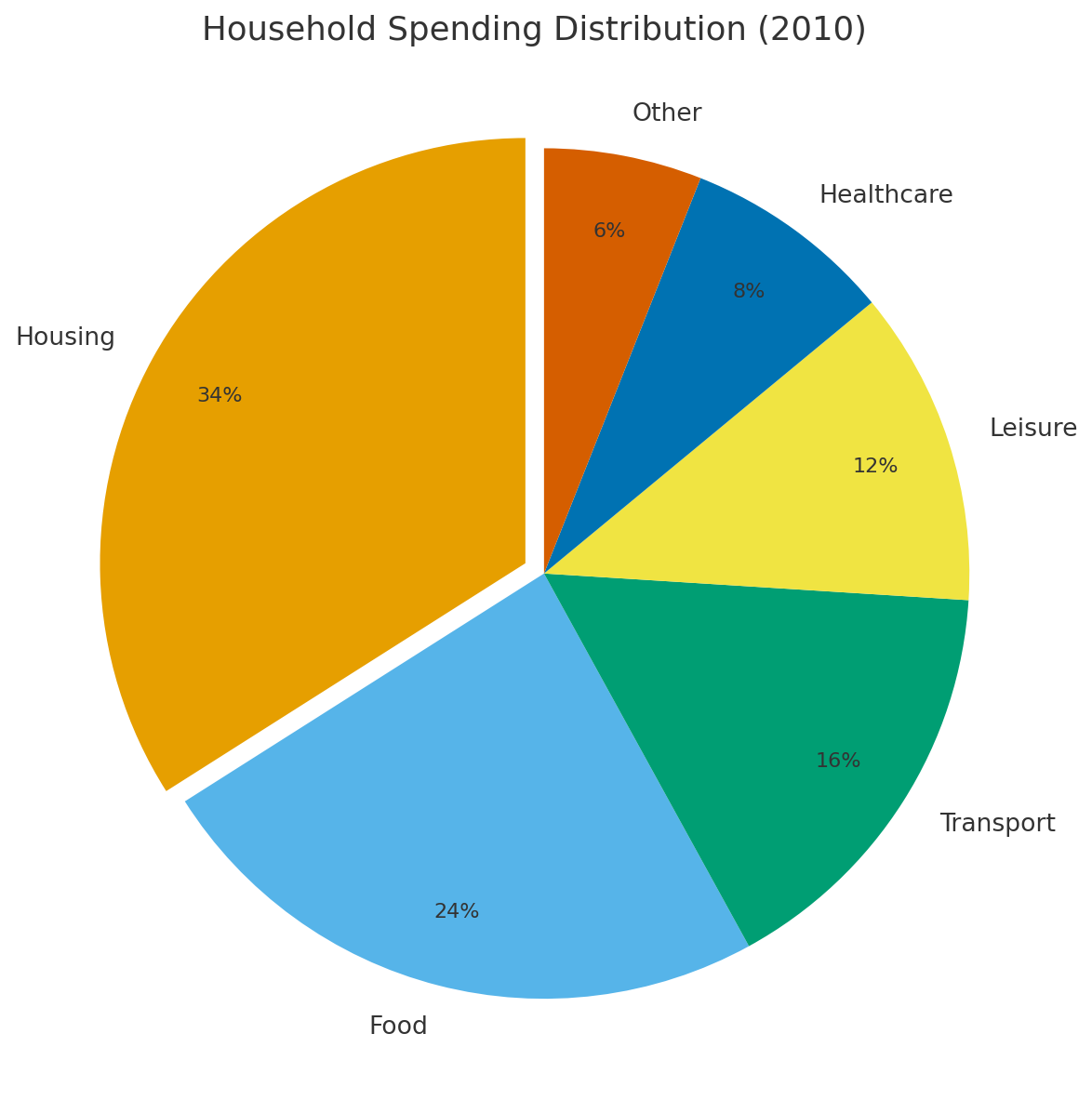IELTS Academic Writing Task 1 – Sample Test03 (Pie Chart)
Task Question
The pie chart below shows the distribution of household spending by category (housing, food, transport, leisure, healthcare and other) in a European country in 2010.
Summarize the information by selecting and reporting the main features, and make comparisons where relevant.

Figure: Household Spending Distribution (2010)
Sample Answer (Band 7.5–8)
The pie chart illustrates how household expenditure was allocated across six categories in 2010. Overall, housing accounted for by far the largest share of the budget, while healthcare and other items represented the smallest proportions.
Housing comprised the biggest slice at 34%, followed by food at 24%. Transport made up a further 16%, whereas leisure represented 12% of total outgoings. By contrast, spending on healthcare and other items was comparatively modest, at 8% and 6%, respectively.
Taken together, essentials such as housing and food absorbed nearly three fifths of total expenditure (58%), indicating that necessities outweighed discretionary areas like leisure. Although transport formed a substantial share, it remained well below housing and food. In short, the data reveal a spending pattern dominated by accommodation costs, with non-essentials contributing only a minor fraction.
Analysis of the Sample Answer – IELTS Academic Writing Task 1 (Pie Chart)
- Strengths:
- ✔️ The response provides a clear overall trend early in the answer, highlighting that housing dominated spending while healthcare and other items accounted for the smallest proportions.
- ✔️ Accurate use of percentages and comparative language (e.g., “accounted for by far the largest share,” “by contrast”) demonstrates good lexical resource.
- ✔️ The structure is logical, moving from the largest categories to the smallest, which improves coherence and cohesion.
- ✔️ Appropriate academic tone and formal vocabulary are maintained throughout, which matches IELTS Writing Task 1 requirements.
- Weaknesses:
- ❌ Limited variety in sentence structures. Most sentences are descriptive; conditional or concessive clauses could showcase greater grammatical range.
- ❌ The analysis focuses mainly on 2010 data. There is no comparison to other time periods or hypothetical trends, which slightly reduces analytical depth.
- ❌ Some vocabulary repetition (e.g., “represented,” “accounted for”) instead of broader lexical variety.
- Suggestions for Improvement:
- 🔹 Use more advanced connectors for variety: “nevertheless,” “conversely,” “notwithstanding.”
- 🔹 Expand sentence openings to avoid repetition. Instead of “Housing comprised…,” try: “While housing consumed over one-third of the budget, food also absorbed a significant portion.”
- 🔹 Add interpretive comments to show deeper engagement with the data. For example: “This suggests that accommodation was regarded as a priority necessity, leaving relatively little for discretionary spending such as leisure.”
- 🔹 Demonstrate complex structures: “Had healthcare spending risen more sharply, it might have overtaken leisure as a larger category.”
- Stronger Vocabulary Alternatives:
- “the biggest slice” → “the most dominant share,” “the predominant proportion”
- “modest share” → “marginal fraction,” “minor contribution”
- “together accounted for” → “jointly represented,” “collectively comprised”
- Band Justification:
Overall, this response achieves the criteria for Band 7.5–8. The answer is well-organized, includes accurate figures, and demonstrates a strong command of academic vocabulary. To consistently reach Band 8.5 or 9, the student should integrate a wider range of sentence structures, use more varied cohesive devices, and provide deeper analytical insights rather than simply describing the data. With these improvements, the response would display the level of sophistication expected at the highest IELTS bands.
Analysis of the Sample Answer – IELTS Academic Writing Task 1 (Pie Chart) / تحلیل پاسخ – تسک ۱ رایتینگ آکادمیک (نمودار دایرهای)
- Strengths (نقاط قوت):
- ✔️ Clear overview at the beginning. ➝ روند کلی در ابتدای متن خیلی واضح بیان شده (مسکن بیشترین سهم، بهداشت و سایر کمترین سهم).
- ✔️ Accurate use of data and percentages. ➝ استفاده درست از درصدها و اعداد باعث میشود متن دقیق و قابل اعتماد باشد.
- ✔️ Logical structure: from largest to smallest categories. ➝ متن به ترتیب از بزرگترین بخشها به کوچکترینها حرکت کرده که باعث انسجام بهتر میشود.
- ✔️ Academic tone maintained throughout. ➝ لحن آکادمیک و رسمی در کل متن رعایت شده است.
- Weaknesses (نقاط ضعف):
- ❌ Limited sentence variety. ➝ تنوع جملهها کم است؛ بیشتر جملات فقط توصیفی هستند.
- ❌ Repetition of vocabulary (“accounted for,” “represented”). ➝ واژههای تکراری استفاده شده؛ میتوانست واژگان متنوعتر باشد.
- ❌ Lack of deeper interpretation. ➝ تحلیل عمیقتر دادهها (مثل دلیل اهمیت مسکن یا رشد کمتر بخشهای دیگر) ارائه نشده است.
- Suggestions for Improvement (پیشنهادهای بهبود):
- 🔹 Use advanced connectors. ➝ به جای "while" یا "although" از عباراتی مثل “nevertheless, conversely, notwithstanding” استفاده کن.
- 🔹 Vary sentence openings. ➝ تنوع در شروع جملهها داشته باش. مثال: “While housing consumed over one-third of the budget, food also absorbed a significant portion.”
- 🔹 Add interpretive comments. ➝ توضیح تحلیلی اضافه کن. مثال: “This suggests that accommodation was considered a basic necessity, leaving less for discretionary spending.”
- 🔹 Show complex grammar. ➝ از جملات شرطی یا امتیازی استفاده کن. مثال: “Had healthcare spending increased more rapidly, it might have overtaken leisure by 2010.”
- Stronger Vocabulary Alternatives (واژگان جایگزین قویتر):
- “biggest slice” → “predominant share,” “most dominant proportion”
- “modest share” → “minor fraction,” “marginal contribution”
- “together accounted for” → “jointly represented,” “collectively comprised”
- Band Justification (توجیه نمره):
This response is strong enough for Band 7.5–8 because it is well-structured, accurate, and includes relevant comparisons. ➝ این پاسخ شایسته نمره ۷.۵ تا ۸ است چون ساختار منظم، دادههای دقیق و مقایسههای مناسب دارد. To reach Band 8.5–9, the student must expand sentence variety, show deeper analytical insights, and use richer vocabulary. ➝ برای رسیدن به ۸.۵ یا ۹ لازم است تنوع جملهها بیشتر، تحلیل دادهها عمیقتر و واژگان متنوعتر استفاده شود.
